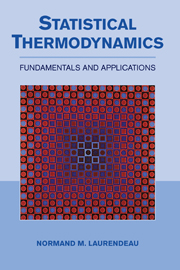Book contents
- Frontmatter
- Contents
- Preface
- 1 Introduction
- PART ONE FUNDAMENTALS OF STATISTICAL THERMODYNAMICS
- PART TWO QUANTUM MECHANICS AND SPECTROSCOPY
- PART THREE STATISTICAL THERMODYNAMICS IN THE DILUTE LIMIT
- 8 Interlude: From Particle to Assembly
- 9 Thermodynamic Properties of the Ideal Gas
- Problem Set IV Thermodynamic Properties of the Ideal Gas (Chapters 8–9)
- 10 Statistical Thermodynamics for Ideal Gas Mixtures
- 11 Concentration and Temperature Measurements
- Problem Set V Chemical Equilibrium and Diagnostics (Chapters 10–11)
- PART FOUR STATISTICAL THERMODYNAMICS BEYOND THE DILUTE LIMIT
- PART FIVE NONEQUILIBRIUM STATISTICAL THERMODYNAMICS
- PART SIX THE ENSEMBLE METHOD OF STATISTICAL THERMODYNAMICS
- PART SEVEN APPENDICES
- Index
8 - Interlude: From Particle to Assembly
Published online by Cambridge University Press: 05 June 2012
- Frontmatter
- Contents
- Preface
- 1 Introduction
- PART ONE FUNDAMENTALS OF STATISTICAL THERMODYNAMICS
- PART TWO QUANTUM MECHANICS AND SPECTROSCOPY
- PART THREE STATISTICAL THERMODYNAMICS IN THE DILUTE LIMIT
- 8 Interlude: From Particle to Assembly
- 9 Thermodynamic Properties of the Ideal Gas
- Problem Set IV Thermodynamic Properties of the Ideal Gas (Chapters 8–9)
- 10 Statistical Thermodynamics for Ideal Gas Mixtures
- 11 Concentration and Temperature Measurements
- Problem Set V Chemical Equilibrium and Diagnostics (Chapters 10–11)
- PART FOUR STATISTICAL THERMODYNAMICS BEYOND THE DILUTE LIMIT
- PART FIVE NONEQUILIBRIUM STATISTICAL THERMODYNAMICS
- PART SIX THE ENSEMBLE METHOD OF STATISTICAL THERMODYNAMICS
- PART SEVEN APPENDICES
- Index
Summary
In this chapter, we summarize and expand somewhat on those results from quantum mechanics and spectroscopy most germane to our study of statistical thermodynamics. We then prepare for revisiting intensive properties in Chapter 9 by considering the nature of thermodynamic calculations before the advent of quantum mechanics. From a pedagogical point of view, the previous three chapters have focused on the properties of a single atom or molecule. For our purposes, the most important such properties are the allowed energy levels and degeneracies corresponding to the translational, rotational, vibrational, and electronic energy modes of an independent particle. Exploiting this knowledge, we proceed to a macroscopic assembly of atoms or molecules, with a focus on calculations of thermodynamic properties for any pure ideal gas. Assemblies composed of different particle types subsequently permit the evaluation of properties for both nonreacting and reacting gaseous mixtures, including equilibrium constants for various chemical reactions. Finally, re-applying spectroscopy to such mixtures, we examine the utility of statistical thermodynamics for experimentally determining temperature or concentrations in realistic gaseous mixtures at high temperatures and pressures.
Energy and Degeneracy
Our foray into quantum mechanics and spectroscopy has led to relations giving the energy and degeneracy for all four energy modes – translation, rotation, vibration, and electronic. If we insist on mode independence, any consideration of diatomic molecules also mandates the simplex model, which presumes a combined rigid rotor and harmonic oscillator.
- Type
- Chapter
- Information
- Statistical ThermodynamicsFundamentals and Applications, pp. 157 - 168Publisher: Cambridge University PressPrint publication year: 2005



